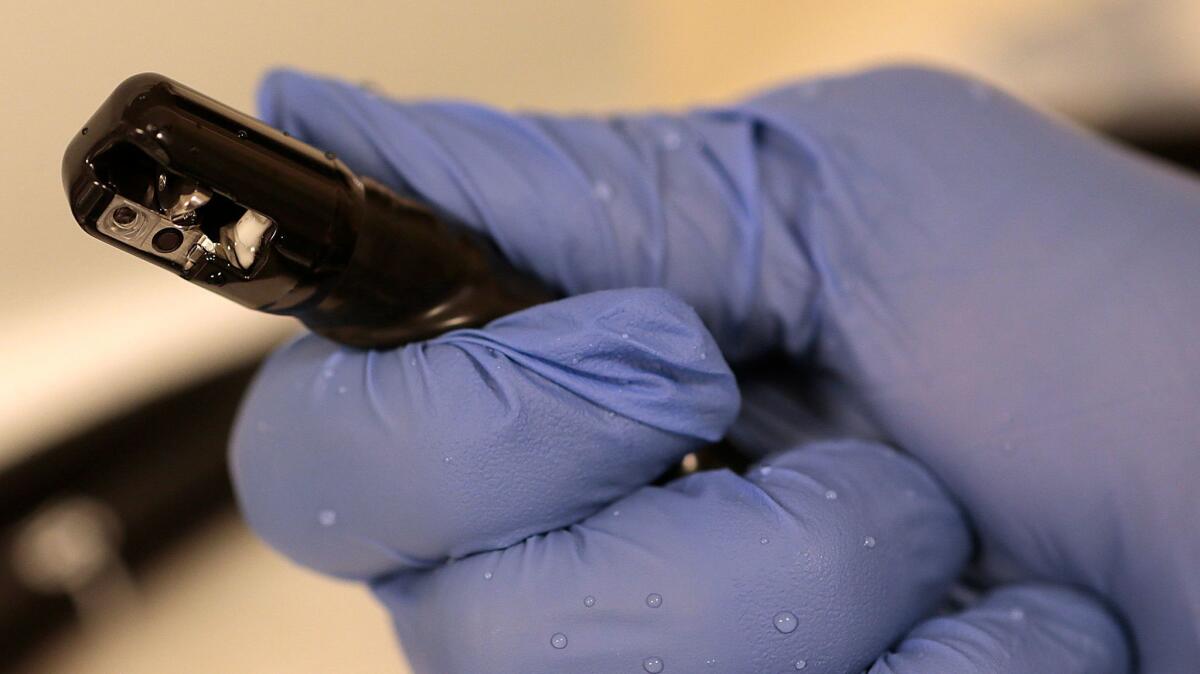Olympus’ redesigned scope is linked to infection outbreak

- Share via
Doctors have tied a superbug outbreak at a foreign health facility to a medical scope that Olympus modified last year in an attempt to reduce its risk of spreading bacteria between patients.
Five patients treated with the modified device tested positive for the same potentially deadly bacteria, according to a report filed with the Food and Drug Administration.
One of those patients died, but the report blamed the death on the person’s pre-existing condition rather than the infection.
American hospitals are currently using about 4,400 of the devices that Olympus voluntarily recalled last year to replace a small mechanism linked to deadly outbreaks around the world.
Several of those outbreaks happened in Southern California hospitals, including at UCLA Ronald Reagan Medical Center two years ago where three patients died, and at Huntington Hospital in Pasadena where 16 patients were sickened. Eleven of the Huntington patients died.
The $40,000 reusable device known as a duodenoscope is a long snake-like tube with a tiny camera on the tip that is inserted into a patient’s throat and upper gastrointestinal tract. It is used to treat cancer, gallstones and other problems in the bile or pancreatic ducts.
In January 2016, Olympus said it was voluntarily recalling all duodenoscope models identified as the TJF-Q180V from American hospitals so that it could replace the mechanism. The company has also recommended new cleaning procedures.
The new outbreak, which happened in December, appears to have occurred in a health facility in another country. A foreign health professional filed the report with the FDA. The facility’s name and location were not disclosed.
The report said that the mechanism on the device had been replaced in October.
Lawrence Muscarella, a medical safety expert in Montgomeryville, Pa., said the outbreak raises questions about whether Olympus’ recall and replacement of the mechanism was enough to keep patients safe.
“Does this new ‘fix’ work?” asked Muscarella, who discovered the outbreak report in the FDA’s database of medical device injuries. He said it was not clear whether the hospital had properly disinfected the device using the process that Olympus now recommends.
The FDA said in January 2016 that it had approved Olympus’ new design of the device.
Deborah Kotz, an FDA spokeswoman, said Wednesday that the agency was “was aware of these reports and continues to investigate adverse events associated with duodenoscopes as appropriate.”
Olympus, a Japanese company with extensive operations in the U.S., told the Times it had notified the FDA of “the reported event.”
“In the interest of patient safety, it is premature to reach a conclusion regarding the cause,” said Mark Miller, an Olympus spokesman.
The five patients in the new outbreak tested positive for a type of Klebsiella pneumoniae that has a gene that makes it resistant to all but last-resort antibiotics.
A series of Times stories reported that Olympus knew of the potential flaws in the scope as early as the spring of 2012, following an infection outbreak in the Netherlands, but failed to alert American hospitals or regulators until after the UCLA outbreak in February 2015.
In 2010 Olympus engineers had changed the scope’s design to seal a narrow internal channel to keep out blood and other infectious material. The change was aimed at making the scope easier to clean.
But three independent investigations — the first in early 2012 — found the design could allow bacteria to remain inside the scope even after it was cleaned according to Olympus’ instructions.
A U.S. Senate probe, initiated by Sen. Patty Murray (D-Wash.), backed up those findings in January 2016, noting it “is now evident” that the scope’s design could “trap and transmit bacteria” even after cleaning.
The Senate report concluded that at least 25 outbreaks were linked to scopes made by Olympus and two other manufacturers.
Olympus is now fighting lawsuits brought by patients and their families.
The U.S. Justice Department is also investigating.
American doctors use duodenoscopes nearly 700,000 times a year in a procedure known as ERCP, or endoscopic retrograde cholangiopancreatography.
Follow @melodypetersen on Twitter
UPDATES:
5:40 p.m.: This article was updated to include the company’s comments.
The article was originally published at 4:20 p.m.
More to Read
Inside the business of entertainment
The Wide Shot brings you news, analysis and insights on everything from streaming wars to production — and what it all means for the future.
You may occasionally receive promotional content from the Los Angeles Times.











